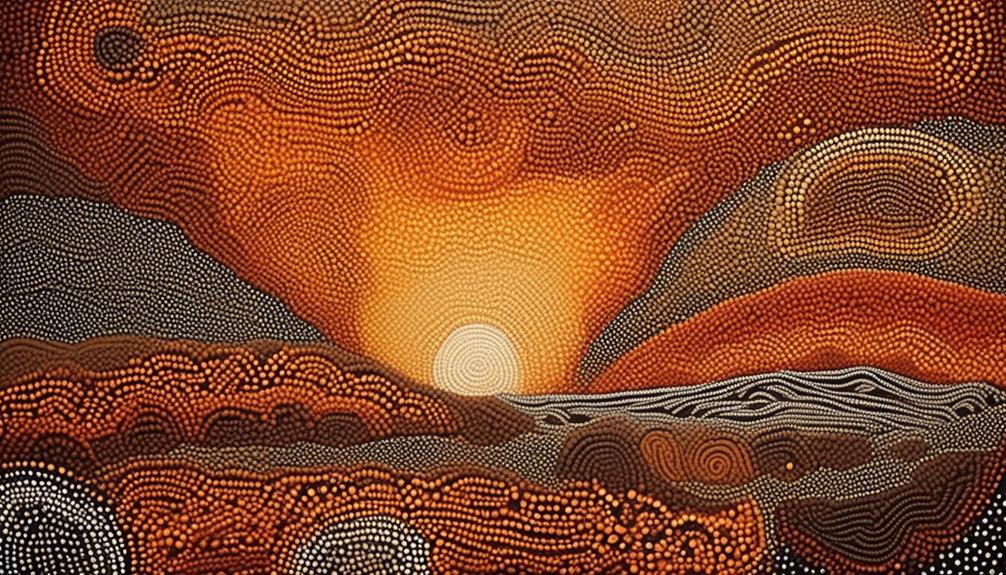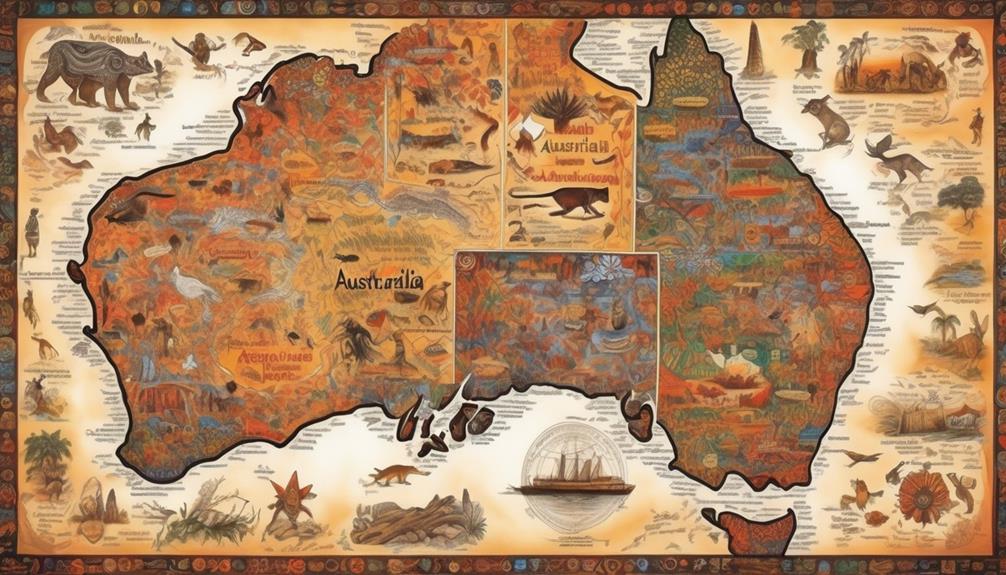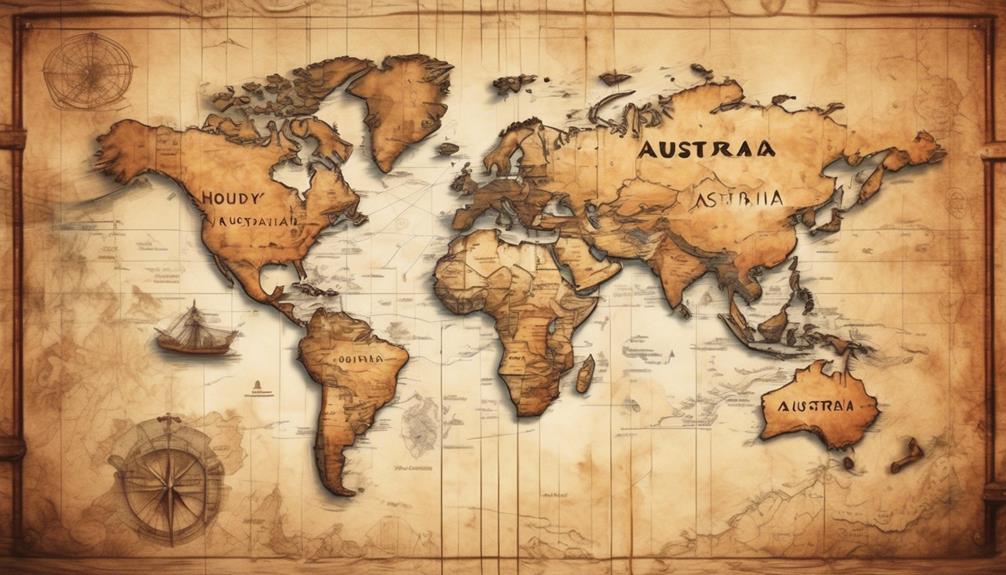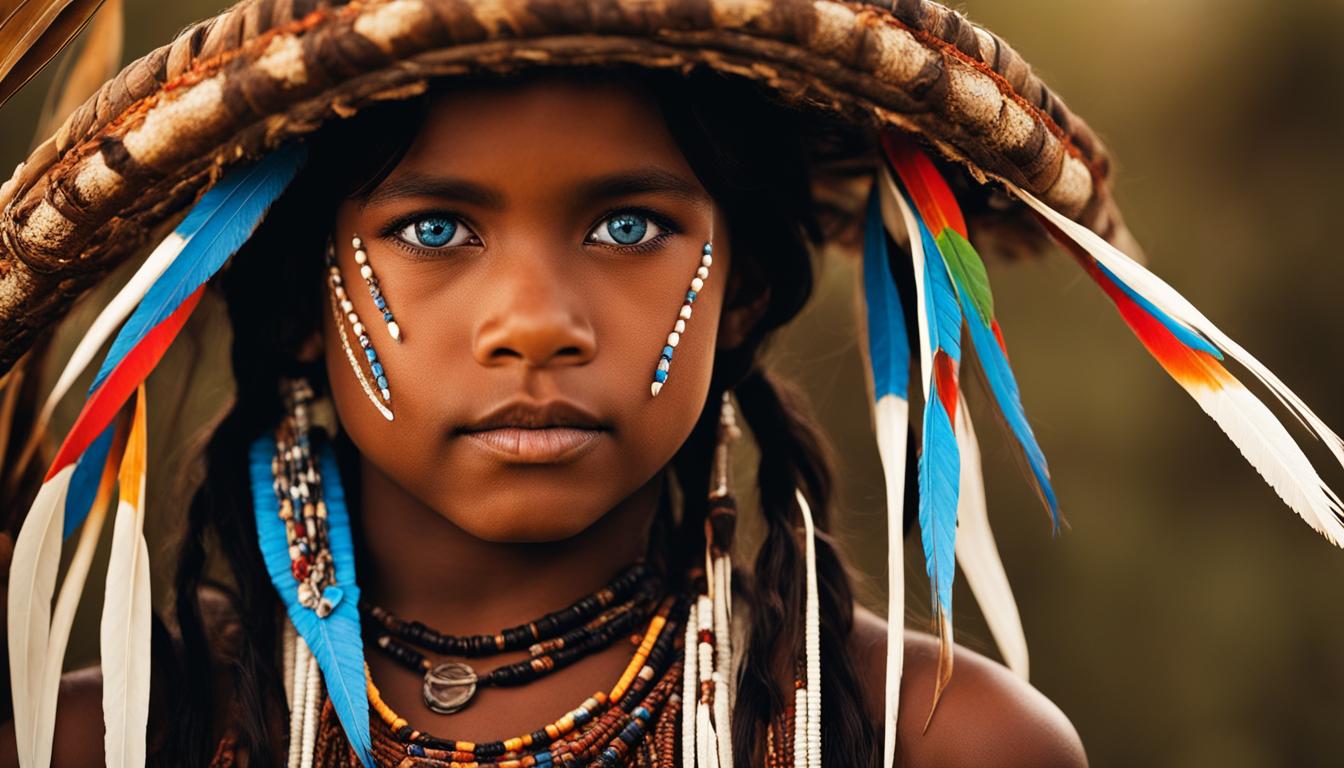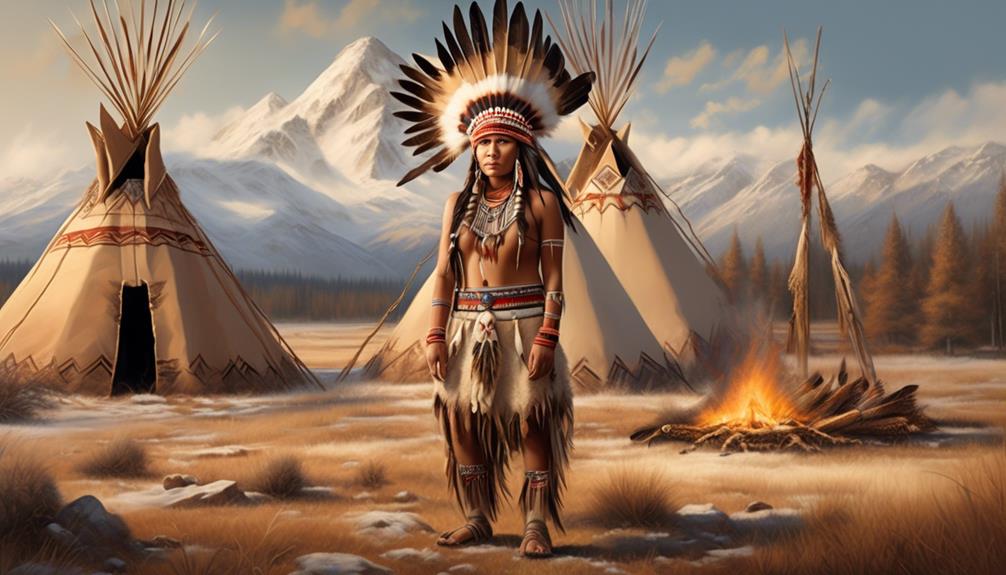It is often said that history is like a puzzle, with each piece revealing a different part of the story. When it comes to the initial arrival of Aboriginal people in Australia, this puzzle becomes even more complex.
The question of when and how the first Aboriginal people arrived on the continent has intrigued researchers and historians for decades. As we explore the various theories, archaeological evidence, and genetic studies, we begin to unravel a narrative that challenges traditional understandings of human migration and settlement.
The journey of the Aboriginals to Australia is not just a matter of historical curiosity; it holds profound implications for our understanding of human history and the diverse tapestry of Indigenous cultures.
Key Takeaways
- Evidence suggests that Aboriginal people arrived in Australia over 65,000 years ago, indicating a long history of human migration to the continent.
- Multiple theories exist regarding the arrival of Aboriginal people, including land bridge theories proposing migration from Southeast Asia.
- Aboriginal cultures have preserved their history and knowledge through oral traditions, providing insights into the arrival and settlement of Aboriginal people in Australia.
- Climate change and the formation of land bridges played a role in facilitating the migration of early Aboriginals to Australia, highlighting the adaptability of early humans.
Early Human Migration to Australia
The earliest evidence of human migration to Australia dates back over 65,000 years. This remarkable revelation challenges previously held beliefs about early migration patterns. As a society hungry for truth and liberation, we must embrace the idea that our ancestors navigated vast distances and unfamiliar terrain to reach the Australian continent.
The journey they undertook speaks to the resilience and adventurous spirit inherent in humanity.
Early migration patterns suggest that these ancient travelers might've utilized land bridges or watercraft to make the arduous trek. This challenges the notion that Australia was isolated from the rest of the world. Instead, it points to a complex network of cultural exchange, where ideas, technologies, and beliefs were shared and evolved over time.
The rich tapestry of Aboriginal cultures and traditions likely reflects this deep history of interaction and interconnectedness.
Cultural exchange theories shed light on the diverse influences that shaped the Aboriginal peoples. It's evident that their story isn't one of isolation, but rather one of connection to a broader human narrative. By embracing this narrative, we can challenge outdated views and celebrate the resilience and adaptability of the first Australians.
As we delve deeper into the complexities of early human migration to Australia, we uncover a story of courage, exploration, and the enduring human spirit.
Aboriginal Arrival Theories

So, let's talk about the various theories regarding the arrival of Aboriginal people in Australia.
We'll give you an overview of these theories, present evidence of early human migration, and discuss the findings from genetic research.
These points will provide a comprehensive understanding of the different perspectives on the arrival of Aboriginals in Australia.
Arrival Theories Overview
After examining various sources and evidence, it becomes evident that multiple theories exist regarding the arrival of Aboriginal people in Australia. These theories offer diverse perspectives on the ancient migration to the continent, raising important questions about the origins of its first inhabitants.
Here are three compelling arrival theories that shed light on this complex topic:
- Climate Change and Human Migration: Some theories suggest that early Aboriginal people may have migrated to Australia during periods of climate change when sea levels were lower, allowing for easier access to the continent.
- Land Bridges: Another theory proposes that land bridges connected Australia to nearby landmasses, facilitating human migration to the continent.
- Oral Traditions: Aboriginal oral traditions provide valuable insights into the arrival of their ancestors, contributing to a rich tapestry of historical narratives.
These theories challenge conventional perspectives and provoke critical reflection on the diverse ways in which ancient peoples may have arrived in Australia.
Early Migration Evidence
Examining ancient artifacts and archaeological findings provides compelling evidence supporting the diverse arrival theories of Aboriginal people in Australia.
Early migration patterns suggest that Aboriginal people may have arrived in multiple waves, challenging traditional theories of a single migration.
The land bridge theories propose that these early inhabitants may have migrated from Southeast Asia via land bridges during periods of lower sea levels.
These findings challenge the previously held belief of a single migration event and indicate a more complex and varied history of Aboriginal arrival.
By understanding these early migration patterns, we can embrace the rich and diverse history of Aboriginal people and their enduring connection to the land.
These discoveries not only reshape our understanding of ancient migrations but also celebrate the resilience and adaptability of the Aboriginal people.
Genetic Research Findings
The examination of genetic research findings further illuminates the diverse arrival theories of Aboriginal people in Australia, expanding our understanding of their complex and varied history.
- Genetic research has revealed multiple waves of migration into Australia, suggesting a more intricate and nuanced picture of Aboriginal arrival than previously thought.
- Studies have identified genetic links between Aboriginal Australians and populations in Southeast Asia, providing new insights into the migration patterns and connections between different regions.
- Analysis of ancient DNA has uncovered evidence of long-term genetic continuity among Aboriginal populations, challenging earlier assumptions about large-scale population replacement.
These findings challenge traditional narratives and empower us to embrace the rich complexity of Aboriginal arrival and settlement in Australia. By understanding the depth of genetic research, we can honor and appreciate the diverse and enduring presence of Aboriginal peoples.
Archaeological Evidence of Arrival

Upon uncovering ancient tools and artifacts, researchers have pieced together evidence of the arrival of Aboriginals in Australia. The archaeological record provides compelling evidence of the enduring presence of Aboriginal people in Australia, dating back at least 65,000 years. The arrival evidence is rooted in the discovery of stone tools, ochre pigments, and ancient fireplaces that have been unearthed at various sites across the continent. These findings not only signify the presence of Aboriginal ancestors in Australia but also shed light on their resourcefulness and adaptation to diverse environments.
The archaeological evidence of arrival complements the genetic migration data, painting a comprehensive picture of the rich and complex history of Aboriginal people. The presence of sophisticated tools, such as ground-edged axes and the use of reflective pigments, indicates a level of cognitive and cultural advancement among the early Aboriginal inhabitants. These artifacts provide a window into the skills and ingenuity of the first Australians, showcasing their ability to thrive in a variety of landscapes and climates.
Moreover, the discovery of ancient rock art and ceremonial sites further emphasizes the deep connection that Aboriginal people have with the land. These sites serve as a testament to the enduring spiritual and cultural practices that have been upheld for millennia. The archaeological evidence not only confirms the antiquity of Aboriginal presence in Australia but also highlights the resilience and rich cultural heritage of the world's oldest living culture.
Genetic Studies and Findings

Through genetic studies and findings, we've gained valuable insights into the ancestral origins and migration patterns of Aboriginal people in Australia. These studies have provided a deeper understanding of the genetic diversity and historical movements of the Indigenous Australians, shedding light on their complex and rich heritage.
Here are three key findings that have emerged from genetic studies:
- Ancestral Origins: Genetic research has revealed that Aboriginal Australians are one of the oldest continuous cultures outside of Africa, with evidence suggesting that they've inhabited the Australian continent for over 50,000 years. Through DNA analysis, scientists have traced the origins of Aboriginal people to the earliest human migrations out of Africa.
- Migration Patterns: Studying the genetic markers and variations among different Aboriginal groups has allowed researchers to map the historical migration patterns across the Australian continent. This has provided valuable insights into how populations moved, interacted, and diversified over tens of thousands of years, contributing to a more comprehensive understanding of Australia's ancient human history.
- Genetic Diversity: The genetic studies have highlighted the remarkable diversity within Aboriginal populations, showcasing the intricate tapestry of lineages and connections that have evolved over millennia. This diversity not only reflects the deep history of Aboriginal peoples but also emphasizes the importance of preserving and celebrating their unique cultural heritage.
These genetic findings not only enrich our understanding of the deep-rooted history of Aboriginal Australians but also emphasize the significance of respecting and protecting their ancestral legacy.
Oral Histories and Indigenous Knowledge

We rely on Indigenous oral traditions to understand the deep roots of Aboriginal history and culture. Through these traditions, cultural knowledge has been passed down through generations, preserving the rich tapestry of historical storytelling methods.
These oral histories provide invaluable insights into the arrival and settlement of Aboriginal people in Australia.
Indigenous Oral Traditions
Indigenous oral traditions form a crucial part of the cultural heritage and knowledge passed down through generations in Aboriginal communities in Australia. These traditions are deeply rooted in the historical narratives and serve as a means of cultural transmission.
Here are three compelling aspects of Indigenous storytelling and oral tradition that highlight their significance:
- Cultural Continuity: Indigenous oral traditions provide a direct link to the past, allowing for the preservation and continuation of cultural practices, languages, and beliefs.
- Interconnectedness: Oral histories emphasize the interconnectedness of all living beings and the land, fostering a holistic understanding of the world.
- Resistance and Resilience: Through storytelling, Indigenous communities assert their resilience and resistance against colonial oppression, reclaiming their narratives and identities.
These aspects underscore the vital role of Indigenous oral traditions in preserving and sharing knowledge within Aboriginal communities.
Cultural Knowledge Transfer
Drawing upon centuries-old oral traditions, Aboriginal communities in Australia have long utilized storytelling as a primary means of transferring cultural knowledge and preserving their rich heritage. Indigenous knowledge is passed down through generations via intricate oral narratives, embodying spiritual, ecological, and historical insights.
This cultural transmission fosters a profound connection to the land, fostering a deep understanding of sustainable living practices and environmental stewardship. Through these stories, wisdom about land management, traditional healing, and social governance is imparted, ensuring the preservation of indigenous customs and values.
This knowledge transfer is crucial for the continuity of Aboriginal culture, empowering communities to maintain their identity and resilience in the face of modern challenges. As we explore the significance of cultural preservation, it becomes evident that these oral histories aren't just stories but living repositories of wisdom that sustain the fabric of indigenous heritage.
Historical Storytelling Methods
Utilizing storytelling as a primary means of transferring cultural knowledge and preserving their rich heritage, Aboriginal communities in Australia have upheld historical storytelling methods through oral histories and indigenous knowledge.
Oral Histories: Aboriginal communities have passed down historical interpretations through spoken narratives, ensuring that their stories remain alive and relevant.
Storytelling Techniques: Aboriginal storytelling techniques involve using symbols, metaphors, and personification to convey historical events and cultural values. These techniques enrich the narratives and make them engaging for the audience.
Indigenous Knowledge: Aboriginal communities possess a deep understanding of their history and culture, which is conveyed through storytelling, providing valuable insights into their way of life and historical experiences.
Climate Change and Land Bridges

As climate change altered the Earth's landscape, land bridges formed, allowing for the migration of early Aboriginals to Australia. Sea level changes, caused by climate shifts, were instrumental in shaping the geography of the ancient world. During periods of glaciation, when vast amounts of water were locked up in ice, sea levels dropped, exposing land that had previously been submerged. This created pathways that early humans could traverse, leading to the land bridge theory of human migration.
The land bridge theory suggests that as sea levels fluctuated due to climate change, passages between continents were revealed, enabling the movement of ancient peoples. In the case of Australia, these land bridges connected the mainland to nearby landmasses, such as Papua New Guinea, providing a route for the arrival of Aboriginal ancestors. The ebb and flow of the seas, influenced by the Earth's changing climate, played a pivotal role in shaping the prehistoric world and facilitating the spread of human populations.
Understanding the impact of climate change and land bridges on human migration provides valuable insights into the interconnectedness of our ancient ancestors with the natural world. It emphasizes the adaptability and resourcefulness of early humans as they navigated and settled diverse environments. By examining these historical processes, we gain a deeper appreciation for the resilience and ingenuity of the Aboriginal people and their enduring connection to the land.
Dating Aboriginal Settlements

We use carbon dating methods to determine the timeline of Aboriginal settlements in Australia. This method provides us with valuable insights into the age of archaeological sites and the activities of ancient Aboriginal communities.
Artefact analysis techniques also help us understand the timeline of Aboriginal settlements. By studying the artifacts found at archaeological sites, we can gain insight into the activities and lifestyle of ancient Aboriginal communities.
Additionally, landform and environment studies play a crucial role in determining the timeline of Aboriginal settlements. By studying the natural landscape and environmental conditions of a site, we can understand how it was used and occupied by Aboriginal communities throughout history.
Carbon Dating Methods
How accurately can carbon dating methods determine the age of Aboriginal settlements in Australia?
- Radiocarbon dating: By analyzing the decay of radioactive carbon isotopes in organic materials, we can estimate the age of artifacts and settlements.
- Stratigraphic analysis: Examining the layers of soil and sediment can provide crucial chronological information, allowing us to understand the sequence of human occupation.
- Environmental adaptations, sea level changes: Considering the impact of environmental changes, such as sea level fluctuations, on the location and timing of Aboriginal settlements enhances the accuracy of dating methods.
Carbon dating methods, when combined with stratigraphic analysis and a deep understanding of environmental adaptations and sea level changes, offer a robust framework for determining the age of Aboriginal settlements in Australia.
These methods liberate us from the constraints of uncertainty, allowing for a clearer understanding of the timeline of human occupation on this ancient land.
Artefact Analysis Techniques
Exploring the timeline of Aboriginal settlements in Australia, artefact analysis techniques play a crucial role in determining their age and understanding the depth of human occupation on this ancient land. Artefact interpretation and cultural preservation techniques are vital in uncovering the history of Aboriginal communities. Through meticulous analysis, archaeologists can date artefacts using various methods. One common approach is optically stimulated luminescence (OSL) dating, which determines the last time quartz grains in sediment were exposed to sunlight. Another method, thermoluminescence (TL) dating, measures the accumulated radiation dose in ceramics or other heated materials since their last exposure to heat or sunlight. These techniques provide valuable insights into the age of artefacts, contributing to a deeper understanding of the Aboriginal presence in Australia.
| Artefact Analysis Techniques | Description |
|---|---|
| OSL Dating | Determines last sunlight exposure in sediment |
| TL Dating | Measures accumulated radiation dose in ceramics or heated materials |
Landform and Environment Studies
Landform and environment studies play a crucial role in accurately dating Aboriginal settlements in Australia. Understanding the landform formation and environmental adaptation provides valuable insights into the timing of Aboriginal arrivals and their interactions with the landscape. Here are three key points to consider:
- Geological Significance: Exploring the geological processes that shaped the Australian landforms offers clues about the age of various sites and the potential pathways of human migration.
- Ecological Context: Examining the environmental conditions at the time of Aboriginal settlement sheds light on how Indigenous communities adapted to and modified their surroundings.
- Cultural Landscapes: Investigating the relationship between Aboriginal cultural practices and the landforms they inhabited deepens our understanding of their connection to the environment.
Megafauna Extinction Connection

The connection between the arrival of Aboriginals in Australia and the extinction of megafauna has been a topic of considerable interest among researchers. As we delve into this intriguing aspect of history, it becomes evident that the timing of human arrival and the megafauna extinction align closely. The ancient landscapes of Australia bore witness to the coexistence of these magnificent creatures and the first Aboriginal inhabitants. The debate on whether human activity played a significant role in the megafauna extinction continues to spark discussions and investigations.
Our understanding of the megafauna extinction draws from a combination of archaeological evidence, ecological studies, and Indigenous knowledge. The ancient landscapes of Australia, with their unique flora and fauna, provide crucial insights into the interactions between megafauna and the environment. It's essential to approach this topic with a sense of reverence for the interconnectedness of all living beings and the delicate balance that sustains life.
As we explore the megafauna extinction connection, we must acknowledge the importance of recognizing and learning from Indigenous perspectives. Aboriginal oral traditions and cultural wisdom offer valuable perspectives on the relationships between humans, megafauna, and the land. By embracing diverse sources of knowledge, we can gain a more comprehensive understanding of the factors that contributed to the extinction of these remarkable creatures.
In our quest for knowledge, it's imperative to approach the megafauna extinction connection with humility and openness to alternative viewpoints. By doing so, we can honor the ancient landscapes of Australia and the enduring legacies of the megafauna while seeking to unravel the mysteries of the past.
Coastal Migration Hypothesis

The connection between the arrival of Aboriginals in Australia and the extinction of megafauna has sparked interest in considering the Coastal Migration Hypothesis to shed further light on early human habitation within the continent. When delving into the Coastal Migration Hypothesis, several key points emerge that highlight its significance:
- Land Bridge Hypothesis: The Coastal Migration Hypothesis proposes that early Aboriginals might've utilized now-submerged land bridges or shallow coastal routes to navigate from Southeast Asia to Australia. This challenges previous notions that migration occurred solely through inland routes.
- Coastal Migration Patterns: Researchers have uncovered evidence suggesting that ancient seafaring populations had the capability to navigate open water and may have used the coastline as a means of migration. The presence of early human artifacts along coastal regions supports the idea of a maritime migration route.
- Reimagining Early Habitation: By exploring the Coastal Migration Hypothesis, we're presented with an alternative narrative of human migration and settlement within Australia. This challenges traditional perspectives and prompts a reevaluation of how we perceive the early movements of human populations.
The Coastal Migration Hypothesis offers a compelling perspective on the arrival of Aboriginals in Australia, emphasizing the need to consider diverse migration pathways. Through this lens, we can uncover a richer understanding of ancient human movements and challenge conventional assumptions about early habitation on the Australian continent.
Rock Art and Cultural Signifiers

Exploring rock art and cultural signifiers provides valuable insights into the rich history and traditions of the Aboriginal people in Australia. Rock art interpretation allows us to understand the cultural symbolism evolution of the Aboriginals, providing a window into their beliefs, practices, and daily lives. The art is not just a visual representation but a profound form of communication that transcends time and space, connecting us to the spiritual and cultural essence of the Aboriginal people.
| Emotions | Cultural Significance |
|---|---|
| Awe | Connection to Ancestors |
| Reverence | Preservation of Stories |
| Inspiration | Spiritual Guidance |
| Gratitude | Continuity of Tradition |
The emotions evoked by the rock art and its cultural significance are deeply intertwined. As we stand in awe of the intricate designs and age-old paintings, we feel a profound connection to the Aboriginal ancestors who created these masterpieces. The reverence we hold for their traditions and stories fills us with inspiration and gratitude. It is through these emotions that we can begin to grasp the enduring impact of this ancient art form on the cultural identity of the Aboriginal people.
In understanding the cultural symbolism evolution depicted in rock art, we are not only acknowledging the artistic prowess of the Aboriginals but also affirming their enduring legacy. It is a testament to their resilience and their unwavering commitment to preserving their stories and traditions.
European Contact and Impact

Upon encountering European explorers, Aboriginal communities in Australia experienced significant upheaval and transformation in their traditional way of life. The impact of European contact on Aboriginal communities was profound, leading to a complex and often tumultuous period of cultural exchange and adaptation.
How European Influence Shaped Aboriginal Communities
- Introduction of New Technologies: The arrival of European settlers brought with it new technologies such as firearms, metal tools, and agriculture, which significantly altered the economic and social dynamics within Aboriginal societies.
- Displacement and Dispossession: European colonization led to the forced displacement and dispossession of Aboriginal peoples from their traditional lands, resulting in profound social and cultural disruptions.
- Cultural Exchange and Adaptation: Despite the challenges posed by European influence, Aboriginal communities engaged in a process of cultural exchange, incorporating new elements into their traditions while also resisting and maintaining their cultural identity.
The European impact on Aboriginal communities in Australia can't be understated, as it fundamentally reshaped their way of life. The period of European contact brought both conflict and opportunities for cultural exchange, leading to a complex interplay of adaptation and resilience within Aboriginal societies. Understanding the nuances of this historical interaction is crucial in recognizing the enduring strength and resilience of Aboriginal cultures in the face of significant external pressures.
Aboriginal Diaspora and Diversity

Encountering European explorers fundamentally reshaped the traditional way of life of Aboriginal communities in Australia, leading to a complex period of cultural exchange and adaptation. As we explore the subtopic of 'Aboriginal Diaspora and Diversity', it becomes evident that the impact of European contact catalyzed a significant dispersion and diversification of Aboriginal peoples, shaping their experiences and identities in diverse ways. This dispersion led to the establishment of diaspora connections among various Aboriginal groups, resulting in a rich tapestry of cultural diversity and resilience.
The diaspora connections forged through displacement and relocation have given rise to a profound diversity of Aboriginal experiences. The forced migration due to European colonization led to the formation of new communities and the intermingling of different cultural practices, languages, and traditions. As a result, Aboriginal peoples developed adaptive strategies to navigate the challenges posed by these significant changes, fostering a sense of unity amidst diversity.
Cultural diversity among Aboriginal peoples is a testament to their resilience and capacity for adaptation in the face of adversity. The diverse experiences and identities within the Aboriginal diaspora highlight the strength of ancestral connections and the preservation of unique cultural practices across different regions. This cultural diversity serves as a source of empowerment, allowing Aboriginal communities to reclaim and celebrate their heritage while forging new identities that honor their complex histories.
Colonial Records and Interpretations

Throughout our examination of the historical records, we find a myriad of perspectives and interpretations of the colonial encounter with Aboriginal communities in Australia. These perspectives have shaped our understanding of the complex and often contentious relationships between colonizers and Indigenous peoples. Here are three crucial points to consider:
- Colonial Perspectives: The colonial records often reflect a Eurocentric viewpoint, emphasizing the supposed superiority of the colonizers and portraying Indigenous peoples as inferior or primitive. These accounts frequently justified the displacement, exploitation, and subjugation of Aboriginal communities, perpetuating harmful stereotypes and erasing the rich cultural heritage of the First Nations.
- Indigenous Perspectives: It's essential to recognize and prioritize the perspectives of the Aboriginal communities themselves. Oral histories, traditional knowledge, and Indigenous narratives provide valuable insights into the impact of colonization on their societies, including the loss of land, culture, and autonomy. These perspectives challenge the colonial narratives and offer a more nuanced understanding of the historical and ongoing injustices faced by Indigenous peoples.
- Reclaiming Indigenous Histories: In our exploration of colonial records, it's vital to support efforts to reclaim and center Indigenous histories. This involves amplifying Indigenous voices, acknowledging the enduring legacies of colonization, and confronting the biases inherent in many historical accounts. By doing so, we can work towards a more equitable and truthful representation of Australia's complex past.
In confronting colonial records and interpretations, we must actively seek to dismantle the oppressive narratives that have marginalized Indigenous perspectives for far too long.
Contemporary Aboriginal Identity

In contemporary Australia, the Aboriginal identity encompasses a diverse range of experiences, perspectives, and cultural expressions. Our contemporary identity is a fusion of traditional cultural values and practices with the modern world, as we strive to preserve our heritage while adapting to the challenges of the present. This dynamic identity is shaped by a variety of factors, including historical legacies, social interactions, and political developments.
| Contemporary Aboriginal Identity | Cultural Preservation |
|---|---|
| Diverse range of experiences, perspectives, and cultural expressions | Embracing traditional practices and values while navigating the modern world |
| Shaped by historical legacies, social interactions, and political developments | Passing down knowledge and traditions to future generations |
| Striving for cultural preservation and adaptation | Addressing challenges while maintaining cultural authenticity |
Our contemporary identity is not static; it is a living, breathing entity that continues to evolve as we engage with the world around us. We actively participate in cultural preservation efforts, ensuring that our traditions and knowledge are passed down to future generations. This includes initiatives such as language revitalization, land rights advocacy, and the promotion of cultural awareness. Our contemporary Aboriginal identity is a source of strength and resilience, empowering us to navigate the complexities of the modern world while remaining rooted in our rich cultural heritage.
Implications for Australian History

Our contemporary Aboriginal identity, shaped by historical legacies and cultural preservation efforts, has significant implications for Australian history.
- Cultural Continuity: The enduring presence and resilience of Aboriginal cultures challenge the dominant narrative of Australia's history as solely a product of European colonization. The maintenance of cultural traditions and knowledge systems highlights the rich and complex tapestry of Australia's past, emphasizing the need for a more inclusive and holistic understanding of its history.
- Colonial Impact: The arrival of European settlers and the subsequent colonization of Australia have had profound and lasting effects on Aboriginal communities. Acknowledging the colonial impact on Aboriginal peoples is essential for a comprehensive and truthful historical account. By recognizing the injustices and intergenerational trauma caused by colonization, we confront the darker chapters of Australia's history and work towards reconciliation and healing.
- Historical Reinterpretation: The contemporary Aboriginal identity prompts a reevaluation of historical narratives, challenging existing Eurocentric perspectives and fostering a more nuanced understanding of Australia's past. This reinterpretation encourages the incorporation of Aboriginal voices and experiences into the broader historical discourse, enriching the collective understanding of the nation's history.
The implications of our contemporary Aboriginal identity for Australian history extend beyond mere acknowledgment; they demand a reexamination of historical narratives and a commitment to truth-telling and justice. Embracing cultural continuity and understanding the colonial impact are vital steps towards a more inclusive and accurate portrayal of Australia's past.
Frequently Asked Questions
What Impact Did the Arrival of Aboriginals Have on the Megafauna Population in Australia?
The arrival of Aboriginals had a significant impact on the megafauna population in Australia. Their presence influenced the environment, wildlife, and adaptation of the megafauna.
As they settled and developed hunting techniques, the megafauna population faced challenges and changes in their natural habitat. This interaction between Aboriginals and the megafauna shaped the ecosystem and contributed to the evolution of both human and animal populations in Australia.
How Did the European Contact and Impact Affect the Oral Histories and Indigenous Knowledge of Aboriginals?
As we explore the impact of colonial contact on indigenous knowledge and oral histories, it's like a river meeting the ocean – there's a merging, but also a powerful transformation.
Colonial contact deeply affected the oral histories and indigenous knowledge of Aboriginals, often leading to erasure and distortion.
Yet, despite this, the resilience and strength of these narratives continue to flow, carrying the wisdom and truth of generations.
Are There Any Connections Between the Dating of Aboriginal Settlements and Climate Change and Land Bridges?
We can explore connections between the dating of Aboriginal settlements and climate change and land bridges.
Climate change and the formation of land bridges have likely influenced the timing and patterns of Aboriginal migration and settlement. These environmental factors could have impacted the availability of resources and the suitability of certain areas for habitation.
Understanding these connections can enrich our appreciation of Aboriginal history and their deep connection to the land.
How Has Contemporary Aboriginal Identity Been Influenced by Colonial Records and Interpretations?
Contemporary Aboriginal identity has been significantly influenced by colonial records and interpretations. European contact and settlement dating have impacted the Indigenous interpretations and oral histories.
Colonial influence has shaped Australian history and contributed to the preservation of Aboriginal diversity.
The impact of megafauna and climate change has also played a role in shaping Aboriginal identity.
These factors have contributed to the complex and diverse nature of contemporary Aboriginal identity.
What Are the Implications for Australian History of the Aboriginal Diaspora and Diversity?
When discussing the implications for Australian history of the Aboriginal diaspora and diversity, it's crucial to recognize the rich tapestry of Aboriginal migration and cultural diversity.
Indigenous knowledge has been deeply impacted by colonial forces, shaping the historical narrative. Understanding and honoring this diversity is essential for a more liberated and inclusive history that acknowledges the resilience and contributions of Aboriginal peoples.
Conclusion
In conclusion, the arrival of Aboriginals in Australia is a complex and fascinating story that spans tens of thousands of years.
As the saying goes, 'the past is prologue,' and understanding the history of Aboriginal migration and settlement is crucial for comprehending the rich and diverse tapestry of Australian society today.
It's a reminder that our roots and history shape our present, and that knowledge of the past is essential for understanding the present and shaping the future.
Mary is a passionate writer who brings creativity and a fresh perspective to our team. Her words have the power to captivate and inspire, making her an essential contributor to our content. Mary’s commitment to storytelling and dedication to promoting Indigenous culture ensures that her work touches the hearts of our readers. We’re fortunate to have her as part of our team.

